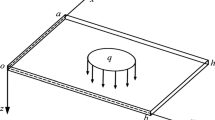Conclusions
One obvious test to which the reflection method must be subjected in order to evaluate its merits is a comparison with the finite difference approach.
Concerning the number of simultaneous equations which must be solved, the reflection method seems to be more advantageous since its equations correspond to a net of points which lie on the boundary and has one dimension less than the space which it encloses. Thus, if the same “net fineness”, i.e., the same distance,h, between adjacent points in the net, is used in the two methods, the ratio of the number of equations in the finite difference method to the number in the reflection method would be approximately (A/2 p h), whereA represents the area (or volume) of the body andp the length (or area) of its boundary. For reasonably accurate results, one should takeh<A/2 p, so that (A/2 p h)>1. On the other hand, it must be recognized that the finite difference method yields a matrix which is more nearly diagonal.
Zusammenfassung
Der Ausdruck «Reflexionsmethode» wird in dieser Arbeit dazu verwendet, ein Verfahren zu beschreiben, mit dessen Hilfe numerische Lösungen für Randwertprobleme der Elastizitätstheorie und der klassischen Theorie der Plattenbiegung gefunden werden können. Das wesentliche an dieser Methode besteht darin, dass das Medium über den Rand ins Unendliche fortgesetzt und ausserhalb des Randes ein System von Lasten eingeführt wird, mit dem sich die Randbedingungen erfüllen lassen. Dass das Verfahren bei vorgeschriebenen Randspannungen verwendet werden kann, ist bekannt. Hier wird es für den Fall formuliert, dass am Rand teils die Spannungen, teils die Verschiebungen vorgeschrieben sind.
Im besonderen wird die Anwendung der Idee auf die Plattenbiegung demonstriert, und es wird gezeigt, dass eine grosse Mannigfaltigkeit von Randbedingungen (Spezifikation der Transversalverschiebung, der Normalableitung, des Kirchhoffschen Schubes und des Biegemoments) zulässig ist.
Die Methode eignet sich insbesondere bei irregulären Rändern.
Similar content being viewed by others
References
Auzas, R. F.,Two Dimensional Stress Distribution by the Reflected Stress Method, Thesis, Princeton University, 1962.
Massonet, C.,Solution générale du problème aux tensions de l'élasticité tridimensionelle, Proc. IX International Congress Appl. Mech., Bruxelles, vol. V, p. 168.
Timoshenko, S. andGoodier, J. N.,Theory of Elasticity, 2nd Ed., McGraw-Hill Book Co., New York, 1951.
Timoshenko, S. andWoinowsky-Krieger,Theory of Plates and Shells, 2nd Ed., McGraw-Hill Book Co., 1959.
Author information
Authors and Affiliations
Rights and permissions
About this article
Cite this article
Chicurel, R., Suppiger, E.W. The reflection method in elasticity and bending of plates. Journal of Applied Mathematics and Physics (ZAMP) 15, 629–638 (1964). https://doi.org/10.1007/BF01595148
Received:
Issue Date:
DOI: https://doi.org/10.1007/BF01595148




